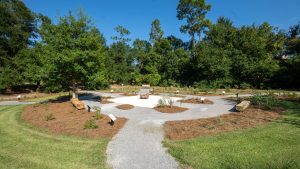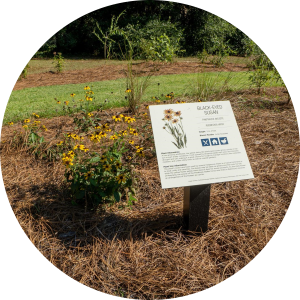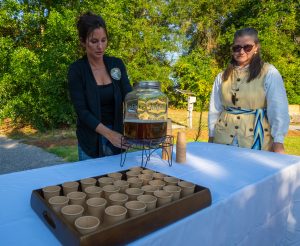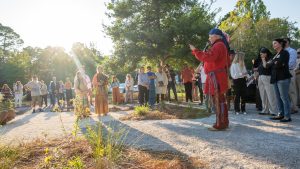
A view of the recently completed UWF Heritage Roots Garden. Photo credit: Mike Thomin, Florida Public Archaeology Network
Just about a year ago, a dream team of history and plant nerds assembled around a common goal. The idea was to transform an open, weedy space adjacent to the University of West Florida (UWF) Archaeology Institute into a lush garden. The garden would be unique, however, in its purpose; to showcase native plants important to the wide swath of humanity that has made northwest Florida home for centuries. The plants featured here were to be planted deliberately, demonstrating how human relationships with vegetation over time have made the area habitable.

This sign describing the edible, medicinal, and building uses of Black-eyed Susan plants is typical of the educational information at the garden. Photo credit: Mike Thomin, Florida Public Archeology Network.
If you walk on the site today, that idea and initial sketches have been made reality. Concentric circles of gravel, mulch, and grass form the shape of a gopher tortoise shell. The tortoise has spiritual significance to members of the local Muscogee tribe and ecological importance as a keystone species. Within the planted space are native groundcovers, shrubs, and trees that have long provided food, traditional medicine, building materials, and dyes and textiles for clothing. This flora makes human life tolerable in a hot, rainy, often difficult environment.

Locally brewed yaupon tea was served as part of the opening ceremony for the garden. Photo credit: Mike Thomin, Florida Public Archaeology Network.
Illustrated signage designed for the site explains ethnobotanical principles, highlighting the relationship that people have had with fifteen plants as they provided healing, nourishment, or protection over the years. The plants are identified on signage in Latin binomial, English common names, and Muscogee language. At the center of the garden is a gravel rectangular space, highlighted by a large piece of local iron rock that represents the tribal Sacred Fire.
One featured plant includes the yaupon holly (Ilex vomitoria), whose leaves are brewed as a highly caffeinated tea. The tea is used ceremonially by many southeastern American Indian tribes, and was popular with early American settlers when tea was difficult to import. Yaupon tea is experiencing a bit of a popular resurgence, with commercial products readily available now. Known as the “black drink,” we all drank a cup of the tasty beverage as part of the open house and ceremonial blessing of the garden a few weeks ago.

Chief Dan Helms of the Santa Rosa Band of the Lower Muscogee tribe blesses the UWF Heritage Garden. Photo credit: Mike Thomin, Florida Public Archaeology Network.
The design team developed a scavenger hunt for youth visitors and is working on a self-guided tour to educate the public about native plants, their cultural heritage, and their role in supporting a healthy watershed. The garden is open to the public during daytime hours, and located near the entrance to UWF at the eastern corner of University Parkway and Campus Drive.
Habitat, whether for wildlife or people, relies on the provision of food, water, shelter, and space. All these needs are met within the UWF Heritage Roots Garden. We hope that visitors will develop a deeper appreciation of the region’s historical and ecological legacy, strengthening modern cultural connections with the past. We hope to tie in the Heritage Garden to other UWF campus garden spaces, including the Edward Ball Nature Trail and the UWF Community Garden.
- University of West Florida’s New Heritage Roots Garden - October 17, 2025
- Katydids - October 3, 2025
- Understanding Fall Webworms - September 11, 2025
